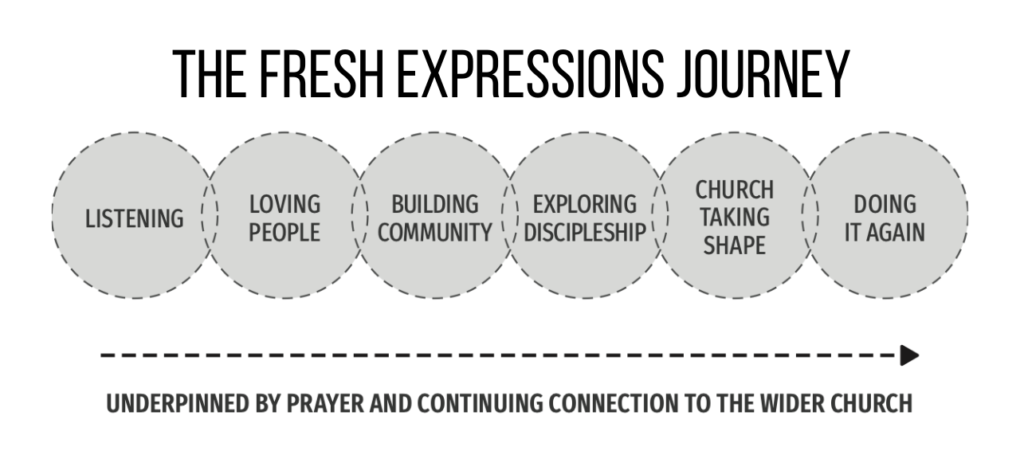The following is an excerpt from Becoming Church: A Trail Guide for Starting Fresh Expressions.
In the summer of 2007, my friends and I graduated from high school and piled into my 1967 Volkswagen Bus for a road trip through Maine that led us to Mt. Katahdin, the northern terminus of the Appalachian Trail. The five-mile hike from the campground is straight up a 5,000-foot mountain, and about halfway up you begin to climb over hundreds of boulders of varying size.
Thoreau described this stretch as “a vast aggregation of loose rocks, as if some time it had rained rocks.” There is no well-worn path to follow. All you have is the occasional trail marker that Appalachian Trail hikers have relied on for two thousand miles—a white standing rectangle that a volunteer slabbed on rocks and trees with the quick swipe of a paintbrush.
Sometimes these white blazes can be pretty far apart. As we hiked in between markers, I would start to feel a little anxiety. Did we get turned off of the trail? I would wonder, Will we need to survive on wild berries until the park rangers find us? After a few minutes the glorious sight of white paint would assure us that we were still heading in the right direction.
Trail markers are nothing new to the church. Monastic communities have lived for millennia with a rule, the community’s agreed upon way of life (e.g., The Rule of St. Benedict). The Latin word we translate as “rule” is regula, which means guidepost.
Guideposts are the collected wisdom of previous travelers that offer direction for our own journeys.
They keep us from wandering off on other paths we might encounter along the way. For monks and nuns these guideposts pointed to a way of forming and growing a community that would be a foretaste of the kingdom of God.
The Fresh Expressions Journey
As fresh expressions popped up throughout the UK, the leaders of the movement identified a path that most had traveled. This path became the six steps of “The Fresh Expressions Journey.” These guideposts have shown the way for thousands of leaders of new forms of church, myself included, and I’m confident they will guide you too. Starting a fresh expression is a hard path to navigate. Without this resource I would have missed signs that our community was ready to take the next step in becoming church.

Here’s a quick glimpse of each step:
Listening. The fresh expressions journey begins with attentive listening to a specific community, to our own interests and social connections, and to God. By listening to our com- munity first, leaders discover the path to starting a church that will resonate with our neighbors.
Loving People. As the process of listening progresses, leaders look for opportunities to love others, deepen existing friendships, and form new friendships with people outside of the church. These are the folks we can invite into our newly forming community. Love is so central to the entire journey that the process is often referred to as a “loving-first journey.”
Building Community. As relationships form between leaders of fresh expressions and their neighbors, a social gathering begins to take shape. These gatherings often begin around shared interests and meet in homes or community spaces.
Exploring Discipleship. This is the hardest transition to make. The leaders patiently look for opportunities to introduce discipleship to the group. Often, the best way for this to happen is to leave the social gathering untouched, inviting folks who have become a part of the group to come to an additional gathering with a simple element of discipleship. Some will come and some will not (and that’s what keeps it from being manipulative).
Church Taking Shape. As disciples are formed, elements of church are added to the group. Elements like the sacraments, the study of Scripture, and worship are slowly incorporated into the budding fresh expression. As more marks of the church are included, the fresh expression of church moves closer to becoming a mature expression of church. Of course, different traditions will define in their own way what constitutes the complete picture of a church.
Doing It Again. After experiencing the process, every member of the fresh expression has the ability to start another one. Individual fresh expressions become networks of fresh expressions, and a movement is born.
Underpinned by Prayer and Continuing Connection to the Wider Church. Starting a fresh expression is a work of the Holy Spirit, and therefore the whole journey is marked by prayerful reflection and discernment. We should be praying as individuals, teams, and churches at every step of the fresh expressions journey. Additionally, most fresh expressions in the US are anchored to existing congregations that can pro- vide leadership, support, and accountability.
It’s Not Necessarily Straightforward
While the fresh expressions journey looks neat and linear on paper, it’s messier in practice. The stages are not always distinct. Listening carries through the whole journey and new relationships are often formed during listening. You will see later that discipleship begins long before we explicitly talk about Christ. We are all starting in different places. Some readers will have many connections in their community and can gather folks quickly. Others will need to spend more time building new relationships. Every journey looks different.
The fresh expressions journey stages are guideposts to help you move forward in the process of becoming church. They keep you heading in the right direction. Your trail companion, the Holy Spirit, is your true guide.
Tweet this.
A Cooking Class for Widowers
A few years back a denominational leader in Australia told me the story of one of his favorite fresh expressions. Two elderly women attended a fresh expressions training and decided to give it a try. As they reflected on their own gifts and began to think of those in their town who were in need of community, an idea came to them. Some of their friends who had passed away left husbands behind, and many of these widow- ers didn’t know how to cook. They ate at restaurants or ate microwave meals every night, and many of them had become socially isolated. When they thought about these men, the women said to themselves, “We know how to cook; we could teach them.” They reserved an industrial kitchen, put an ad in the local paper, and a few weeks later a dozen widowers showed up for their first cooking class.
As they learned to cook, the group prepared a meal, and to close out their time, they ate together. As the class progressed over the coming weeks, they began to take prayer requests and pray together. The fresh expressions journey isn’t just a pathway for hipsters allergic to religious institutions (though there are some of us). It’s for all of us who long to draw our neighbors into the loving embrace of Christian community.
It’s Your Journey
You’re ready to start a fresh expression. It’s why you’re still reading. The path forward from here will not be without its challenges, but you go with Christ and you go with thousands of others who have relied on the trail map called the fresh expressions journey. Every context is different and therefore there is no GPS for this journey, but there are trail markers if you know where to look. In starting King Street Church, and helping over 250 fresh expressions begin their journeys in western North Carolina, I have come to recognize the guide-posts along this lightly worn path, and I’ll do my best to point them out to you. It’s your journey, but you don’t have to make it alone. So lace up your hiking shoes and brace yourself for the unexpected.
This was an excerpt from Becoming Church: A Trail Guide for Starting Fresh Expressions. In the book Luke offers theological reflections, practical ideas, and real-life examples of each step of the fresh expressions journey.


